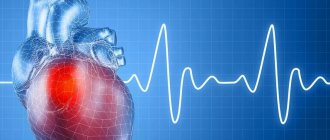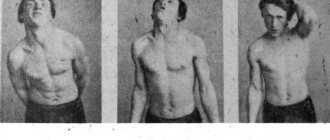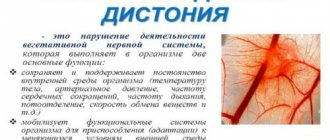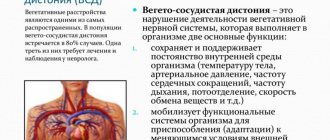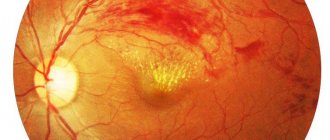Why does VSD occur?
VSD is a congenital genetic disease that most often begins to develop in a child while still in the womb. Such children are born with an unstable psyche and low weight due to oxygen starvation. During pregnancy, the development of dystonia in a baby can be provoked by:
- neuroses, breakdowns;
- stress;
- prolonged depression;
- bad habits (smoking, alcohol);
- excessive emotionality;
- overwork.
Scientists have proven that most often people with VSD are workaholics who are not used to sitting idle.
Symptoms of VSD in childhood and adolescence, when the nervous system begins to respond inadequately to stimuli, may appear against the background of:
- sedentary lifestyle;
- hormonal imbalance;
- ARVI, influenza;
- unbalanced, poor nutrition;
- lack of vitamins and microelements in the body;
- poisoning, intoxication;
- psychological problems: lack of willpower, inability to control one’s desires.
Causes of dystonia
The danger posed by VSD is directly proportional to the cause of its occurrence. Disturbances in nervous regulation can be triggered by a wide range of problems, ranging from psychological disruptions to serious internal pathologies.
The causes that provoke vegetative-vascular dystonia can be divided according to the stages of their occurrence:
- Pregnancy.
During the period of prenatal development of the fetus, the future appearance of dystonia can be affected by oxygen deprivation, trauma during intrauterine development or during childbirth, and maternal use of alcohol, nicotine, and narcotic substances.
- Childhood.
In the first years of life, a determining role can be played by an unbalanced diet, a sedentary lifestyle, severe illnesses, an unfavorable family environment (the presence of regular conflicts and a tense atmosphere), and experienced psychological trauma.
- Teenage years.
At this time, hormonal changes in the body, increasing mental stress, emotional disorders taken as manifestations of “adolescence”, a sedentary lifestyle and the prevailing number of hours spent at the computer are added to a number of previous reasons.
- Mature age.
Hormonal changes in women during pregnancy, advanced pathological diseases, prolonged smoking and alcohol consumption, excessive workload (both physical and mental - the origins of VSD are often associated with working at the computer), prolonged exposure to stress, undisclosed causes of the development of neuroses and violation of the regime is just a small list of reasons that can cause disruption in the course of the nervous regulation of the body.
Additional factors for the development of VSD
At any age, in addition to the main common causes, third-party complications can also arise. They do not depend on a person’s healthy lifestyle.
These include:
- External psychological trauma and shock, heated general social situation (introduction of martial law, conditions of crisis and shortage, tragedies in the family and close circle).
- Changes in the climate situation, unfavorable environmental conditions of the area.
- Penetration of viral infections into the body, consequences of severe and/or chronic intoxication.
- The manifestation of allergic reactions to new irritants.
Causes and mechanism of development of VSD
Diagnostic studies indicate that this set of symptoms is a consequence of an imbalance in the functioning of the autonomic nervous system. Unlike the somatic nervous system, which is controlled by consciousness and reason, the autonomic nervous system works without our participation.
This is the regulation of breathing, heart contractions, focusing of vision and other basic functions of the body depending on environmental conditions: for example, accelerating the reaction and increasing the heart rate in extreme conditions or slowing down breathing and relaxing muscles during sleep.
This part of the nervous system always works: from the moment a person is born and literally until death.
Treatment of vegetative-vascular dystonia
Treatment of this disease is long-term, requiring parallel use of prevention methods. Psychotherapy always takes first place, since most often patients have a weak nervous system. The choice of medications depends on which organ system is affected.
For psychoneuralgic VSD, antidepressants and tranquilizers are prescribed, but they can be replaced with herbs: valerian, hawthorn, motherwort, peony, wild rosemary. In addition, medications containing bromides, barbiturates (Corvalol, Valocordin), adaptogens (schisandra, ginseng), diuretics (lingonberry, bearberry, parsley, nettle), vitamins A, B, C, E, calcium, and preparations with garlic are needed.
Treatment of VSD primarily involves lifestyle changes.
It is absolutely necessary to organize the patient’s life in such a way as to ensure the correct mode of work, rest and sleep, and a sufficient amount of physical activity in accordance with age and individual characteristics of the body. During the rehabilitation period, the doctor may prescribe physical therapy and spa treatment.
It is absolutely necessary to change your diet - exclude salt from it, with high blood pressure add cottage cheese, legumes, cereals, salads, with low blood pressure - coffee, green tea, dairy products, cheeses and fish. When preparing a diet, you should pay attention to replenishing the body with iron, phosphorus, fluorine, potassium, manganese, and vitamins. It is advisable to simultaneously cleanse the body with tea or milk mushroom.
Forms and methods of classification of VSD
The earliest and most established is the division of vegetative-vascular dystonia into two types of course - sympathotonic, vagotonic. These two conditions are radically different from each other in clinical course.
With sympathotonic dystonia, the patient is overly active, proactive, and efficient. However, this seemingly good condition has a negative side - sleep disturbances, a constant feeling of anxiety. The patient's appearance is similar to that of hyperthyroidism:
- shiny eyes, slightly bulging;
- dry skin;
- rapid heartbeat, breathing.
The vagotonic type of vegetative-vascular dystonia is characterized by excessive slowness and drowsiness. It is difficult for the patient to make choices and important decisions. Externally, moist skin, increased sweating, and salivation will be observed. There is a decrease in heart rate and breathing.
With this pathology, no morphological changes are detected in any internal organs. However, VSD and its consequences are manifested by symptoms that resemble various diseases, mainly of the heart and digestive tract. So why is VSD dangerous? Can vegetative-vascular dystonia lead to serious complications?
The symptoms of this unpleasant condition directly depend on the type of dystonia. There are:
- dystonia of the hypotensive type, the symptoms of which are: excessive fatigue and lethargy, fatigue, weakness, dizziness, coldness, numbness of the lower and upper extremities or fingers;
- dystonia of the hypertensive type, the symptoms of which are: pressure surges, imbalance, pain in the heart and stomach, a feeling of lack of oxygen, shortness of breath when lifting heavy objects.
There is a conditional division of this vascular disease according to characteristic signs and manifestations. All of them require careful attention to the first signs of the disease, since it is in the first stages of the pathological process that it is most easy to stop the pathological process of development and prevent the progression of this type of damage to the nervous system.
This disease is divided into the following types:
- Permanent form - with this type of VSD, the deterioration of the condition occurs smoothly, there are no sudden changes in well-being, and the patient is not too much knocked out of the usual lifestyle by the manifestations of the disease.
- Paroxysmal, or paroxysmal, form, in which deterioration of the general condition occurs only during crises, or attacks. In the periods between attacks, during remission, the patient feels quite well, without a sharp deterioration in health. However, during attacks, the maximum possible manifestations of the disease are present.
- The mixed form is the most common, which combines the symptoms of the first two forms of the disease. There are crises (attacks) with sharp manifestations, and periods of remission, as well as a gradual deterioration of the patient’s condition.
- Latent form (or hidden). In this case, manifestations of the disease may not occur for a long time, while the pathological process is active, and manifestations can occur only when certain circumstances arise that stimulate the disease to enter an obvious phase. For example, with prolonged stress, a decline in the level of immunity.
And since the symptoms and treatment of different forms of the disease are interrelated and their degree of development depends on the neglect of the pathological process, identifying the form based on current symptoms makes it possible to more quickly eliminate both the symptoms of the disease and its root cause.
Important! Vegetative-vascular dystonia, the symptoms of which make it possible to immediately determine both the type and the cause of the disease, are most easily curable. Therefore, careful attention to your well-being and regular examination by a doctor will avoid the deepening of the pathological process.
How to get rid of VSD
In the process of treating a disease called “vegetative-vascular dystonia,” you should completely and completely trust your doctor. People in white coats have undergone special training and sensibly assess the situation when prescribing treatment for you. Be that as it may, productive self-medication is also possible in the case of VSD.
If you really feel that your emotional state has been getting out of control lately and you are feeling something new and unpleasant, you can consult a psychiatrist. This does not mean that you have mental problems and are close to going crazy.
It is recommended to overcome the fear of seeing this doctor as quickly as possible. Because again, a specially trained specialist will give you a psychiatry opinion about you.
Pay attention to your lifestyle. Create a proper diet for yourself, walk for 2-3 hours every day, increase your daily dose of sleep to 8-9 hours. Diversify your life with active sports by visiting the gym. Think back to times when you were crazy about your life and compare what you're missing now.
Think positively. Life brings all sorts of surprises, including both good and bad.
But having received news of a not-so-desirable disease, you should under no circumstances despair and give up on yourself. Filling your head with bad thoughts, even to the point that you supposedly have to die, will not help your case in any way.
On the contrary, it is even dangerous. Smile, spend time in the company of loved ones, try to live life to the fullest.
Dangerous symptoms of dystonia
Diagnosis of vegetative-vascular (another name is neurocirculatory) dystonia is often difficult due to the wide variety of symptoms described by the patient. For many, this is manifested by increased heart rate, sweating, chills, trembling limbs and chest pain.
For some, it is accompanied by a headache, pressure surges, difficulty breathing or shortness of breath. Some feel nausea, sometimes to the point of vomiting, and sudden urges to urinate.
All this is also classified as symptoms of autonomic disorder.
Factors that contribute to the occurrence of the disease
Vegetative-vascular dystonia, in addition to natural causes, can occur due to the body’s predisposition to such diseases.
It can be noted that quite often this manifests itself in those who:
- has a family member who suffered from VSD. NS diseases, unfortunately, can often be inherited. If the child’s parents (or one of them) were too susceptible to various irritants in their youth, prone to phobias, or experienced constant fear, the child may also have similar symptoms;
- has diseases of the endocrine glands. People with diseases of the gonads, thyroid gland, and adrenal glands have a high risk of contracting the disease in question;
- has org. brain damage. Patients who previously had tumors and brain injuries, strokes close to death, are quite vulnerable to vegetative-vascular dystonia;
- undergoes a stage of endocrine restructuring of the body. Vegetative-vascular dystonia quite often occurs in a person during that period of life when not only the restructuring of the nervous system occurs, but also hormonal changes occur.
Basic methods of treating VSD
To diagnose this condition, it is necessary to conduct a series of studies that will exclude pathological conditions that have similar manifestations (for example, epilepsy) and obtain the most complete picture of the current disease. A number of measures aimed at studying the condition of the patient’s body will make it possible to create an optimal treatment method.
Diagnostic measures for suspected vegetative-vascular dystonia include:
- EEG;
- magnetic resonance imaging;
- electrocardiography;
- magnetic nuclear resonance.
Obtaining the results of all of the above examination methods, taking into account the patient’s complaints, will allow us to prescribe optimal treatment.
How to treat VSD? The doctor will answer this question more fully, but general recommendations will be the absence of negative emotions, complete avoidance of stress and nervous strain, stabilization of the emotional background, as well as sufficient physical stress in the form of standardized physical activity.
Prevention of VSD should begin from a very young age, and in this case, even in adulthood, it is possible to avoid serious consequences of VSD with possible complications in the form of concomitant diseases.
Bottom line
As with other diseases, prevention of VSD and its complications is preferable to treatment. After all, at the initial stages we are talking only about a functional disorder, which, with due diligence, can be normalized in most patients, while the presence of complications indicates more serious changes in the functioning of the body.
In order to prevent this, you need not to tolerate the symptoms of dystonia, do not think that they will go away on their own, but contact medical institutions and follow the recommendations of doctors. Because it is lifestyle changes in the early stages that make it possible to most successfully combat this disease, thereby reducing the risk of complications.
What diseases is VSD disguised as?
This condition can resemble many diseases.1. Diseases of the heart and blood vessels:
- pain syndrome localized behind the sternum;
- cardiopalmus;
- dizziness;
- a feeling of heart failure.
2. Respiratory diseases:
- paroxysmal cough;
- rapid breathing;
- feeling of suffocation during physical exertion.
3. Diseases of the digestive organs:
- feeling of discomfort in the abdomen;
- periodically loose stools;
- nausea, possible vomiting.
As you can see, the clinical picture of the pathological condition is very diverse. These symptoms appear in patients regardless of gender and age. Children begin to present these complaints from the age of seven to eight years. Sometimes parents take this for ordinary whims. But the child actually needs help.
Consequences of VSD
The consequences of vegetative-vascular dystonia are especially dangerous in old age, since the body is weakened. Pre-stroke conditions can often develop, which are dangerous due to hemorrhage in the brain. If we summarize the latest statistical studies, we can say that young people are more susceptible to the disease.
At the age of 50-55 years, in the presence of VSD, women may experience menopause more severely. In this case, there is increased sweating, shortness of breath, surges in blood pressure and periodic fainting. In some cases, hospitalization may even be required.
In men, the pathology is more severe. Erectile function may suffer.
With constant stress on the nervous system, a person becomes emotionally unstable. He is often tormented by nightmares, headaches, and sleep disturbances.
Against the background of VSD, restless legs syndrome often develops, which is more typical for the female population. This disease is one of the serious consequences, as it interferes with proper sleep.
A woman with this pathology often falls asleep only in the morning, since she has to constantly get up and walk around the room to remove the discomfort from her legs.
krov.expert
Symptoms of VSD can be pronounced. It is important to identify them as early as possible and remove them, avoiding the unpredictable consequences of dystonia.
If VSD is not treated in time, the process may become advanced. As a result:
- phobias;
- dyspnea;
- constant yawning;
- heaviness and pain in the chest;
- night pressure surges;
- heart rate failure;
- tachycardia;
- weight loss with VSD
- belching, flatulence;
- increased stomach acidity;
- prostatitis in men and deterioration of reproductive functions;
- sexual dysfunction and hot flashes in women;
- chilly hands;
- deterioration of blood circulation.
It is important to understand that the symptoms of VSD are not fatal. The person will not die, but the consequences of dystonia can be complex: ischemia, heart failure, stroke, heart attack, arrhythmia in adults with VSD. All diseases can be fatal, and statistics show that the mortality rate of patients with these pathologies is more than 60%.
The result of advanced dystonia can be:
- neurological, psychological, cardiac disorders;
- signs of hypotension and hypertension;
- difficulty urinating, involuntary urge to go to the toilet;
- decreased vision;
- increased sensitivity to weather conditions;
- weight loss, when gaining kilograms back is almost impossible;
- development of anemia;
- spasms of blood vessels in the head during VSD;
- headaches and dizziness due to poor blood supply;
- causeless anxiety, increased anxiety;
- neuroses and depression;
- psychological vulnerability;
- apathy or, as people say, depression, which can become prolonged.
Treatment with sedatives is required, and to relieve stress, the help of a psychologist is needed.
It is important to undergo a treatment course to stabilize the condition of VSD and take medications prescribed by a doctor. Long-term dystonia can negatively affect almost all systems and organs in the body.
Symptoms of VSD, immediately attracting attention, make it possible to diagnose this condition in a timely manner. And in this case, if it is diagnosed in the early stages of development, recovery is likely in a short time.
However, many such manifestations of the disease as frequent headaches, increased fatigue, poor quality sleep at night and low performance are perceived as a normal phenomenon in an overly active and busy daily life.
And with advanced stages of VSD, longer and more complex treatment is required, affecting many systems and organs, and also requiring adjustments to the patient’s lifestyle, nutrition and daily routine.
Prevention of VSD
Doctors talk a lot about the prevention of dystonia, because this is the basis of a healthy, fulfilling lifestyle. From an early age, seasonal colds should not be allowed in children. It is necessary to accustom him to physical education and conduct hardening. Dancing, swimming, jogging, and brisk walking in the morning and evening are useful for dystonia.
Teenagers are advised to reconsider their inner world, get rid of bad thoughts and phobias. Sign up for a course of auto-training or meditation if you are worried about stress, anxiety, or symptoms of depression.
With dystonia, it is important to find harmony between work and rest, to avoid mental fatigue and physical overexertion. You need to rest more, walk in the fresh air. Change your occupation if your job is sedentary and health problems become obvious.
It is equally important for patients with VSD to fight bad habits, moderate exercise, try to calm down and normalize sleep. You can always take a glycine tablet (putting it in your mouth under your tongue) or valerian infusion. The main thing is to prevent manifestations of VSD, not to let dystonia take over the condition.
The disease is not fatal and can be cured. You just need to learn how to deal with it correctly. The main thing is to eliminate any factors that provoke VSD from life and support your body.



